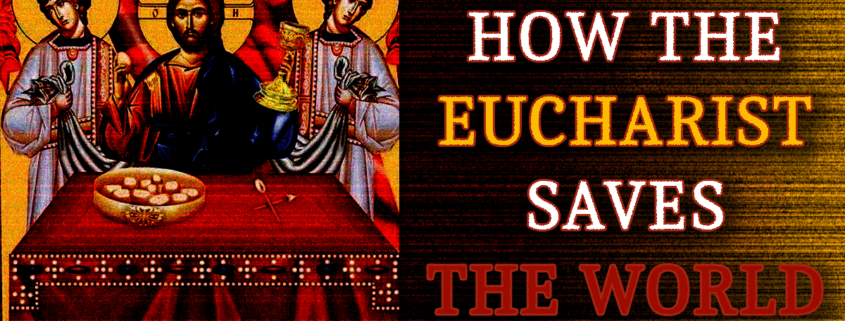How the Eucharist Saves the World
You are what you eat.
—Jean Anthelme Brillat-Savarin
The ritual of eating meals is the heart and soul of civilization. It forms boundaries between tribes and borders between nations. It helps us survive and tells us who we are.
In every religion, there is, in one form or another, a ritual involving a meal. The Jews have Passover, Islam has iftar, Hindus have bhog, and in the earliest, most primitive societies, existed cannibalism. In fact, it can be said that cannibalism, being closely related to human sacrifice, is the root of human civilization.
Humans are a mimetic species, and therefore, their desires are also mimetic, i.e. copied from others. What would often happen, as a result of our imitative nature, is something that Rene Girard called “mimetic contagion.” Rivalry would grow and violence would increase to the point where the very object of the dispute would fade into the background. Ancient societies would stop this out-of-control violence by placing the blame on a single person (or in some cases, a group) and have that person ritually sacrificed. One of the many ways that ritual sacrifice occurred is the murder and cannibalization of the victim.
The importance of cannibalism in forging civilizational practices cannot be overlooked. For example, Psychologist Jean-Michel Oughourlian points out the similarity between cannibalism and animal domestication when he describes cannibalism among the Tupinambá people.
The future victims-prisoners of war are made a part of the community: they work, they marry and have children. They are treated with the kind of double standard accorded the purifying and sacred scapegoat. They are driven to commit certain transgressions and are then persecuted and honoured, insulted and esteemed. Finally they are ritually murdered and devoured, like the bear cub of the Ainu or the animals kept by pastoral societies.1
Girard adds to Oughourlian’s observation:
The cannibalism of the Tupinamba is simply an extraordinary variant of widespread sacrificial forms. In Central America, for example, the future victims in certain rituals have the privilege or obligation to commit certain transgressions, sexual or otherwise, during the interval of time between their selection and immolation.2
From here on, it isn’t hard to imagine how cannibalism might have formed other key civilizational practices, however mundane they may be. One of these practices, owing to the close relation between religion and civilization, must be ritual meal eating. The mystical aura of eating meals, being transmitted from the days of cannibalism, transformed into a sacral practice that formed taboos. In other words, the actual eating of human flesh may have ceased but the sacredness surrounding it did not.
Even today, in the most traditional societies, you will see eating restrictions based on communal divides. In India, there are entire housing colonies within some of the most modernized cities that exclude butcher shops and meat-eating residents. In many regions, people of higher castes are forbidden to eat food touched by those from the lower castes. These examples might seem outdated to average moderns, but remember that liberal publishers routinely push articles on how to handle “racist” uncles and grandpas at Thanksgiving, sometimes even encouraging people not to invite conservatives.
Today, when Catholics and Orthodox Christians celebrate the Eucharist—the eating of Jesus’s flesh and blood—they are often accused of cannibalism. The Catholics and Orthodox recoil at these accusations and say all sorts of things to prove that they aren’t cannibals. Girard, unlike most Catholics, does not shy away:
Primitive cannibalism is religion, and the Eucharist recapitulates this history from alpha to omega.3
In Acts 10, God shows a vision to St. Paul that urges him to recognize all creation as clean. It is no coincidence that Peter’s vision to preach the Gospel to the Gentiles is an illustration of permitted and prohibited animals. Not only did this mean that all types of food were now allowed for consumption, but now Gentiles, Jews, upper and lower castes, in Christ’s family, can eat meals together.
The ritual meal that is to be eaten is no longer that slain victim of human sacrifice, but the Eucharist—flesh and blood of the self-sacrificing Lord of the universe. God, having seen our lust for blood in our desire to solve violent chaos, once and for all solves everything by offering Himself as the ultimate human sacrifice to the human race, thus shattering all violent barriers and bringing humanity together under His rule and companionship.
“It is finished,” said Christ as He breathed his last on the cross. What was finished? The seemingly endless trail of blood left behind in history by the victims of our cannibalistic bloodlust. Jesus was and is the final sacrifice. His story is told in such a way as to thoroughly dismantle our cannibalistic tendencies, that the innocent are deserving of our wrath, and at the same time, satisfy it through the consumption of the Eucharist.
In offering Himself, Christ not only unites the tribes of the world, but He also bridges the great divide between heaven and Earth. Fr. Alexander Schmemann writes:
He became man and lived in this world. He ate and drank, and this means that the world of which he partook, the very food of our world became his body, his life. But his life was totally, absolutely eucharistic—all of it was transformed into communion with God and all of it ascended into heaven. And now he shares this glorified life with us.”What I have done alone I give it now to you: take, eat…4
Creation has been made good again. Food has been made good again. Christ has redeemed the human race. He has become our food, and nothing else, neither artificiality nor the flesh of our neighbor, can satisfy us any longer.
- Things Hidden Since the Foundation of the World, René Girard
- Ibid.
- Evolution and Conversion, René Girard
- For the Life of the World, Fr. Alexander Schmemann










Leave a Reply
Want to join the discussion?Feel free to contribute!